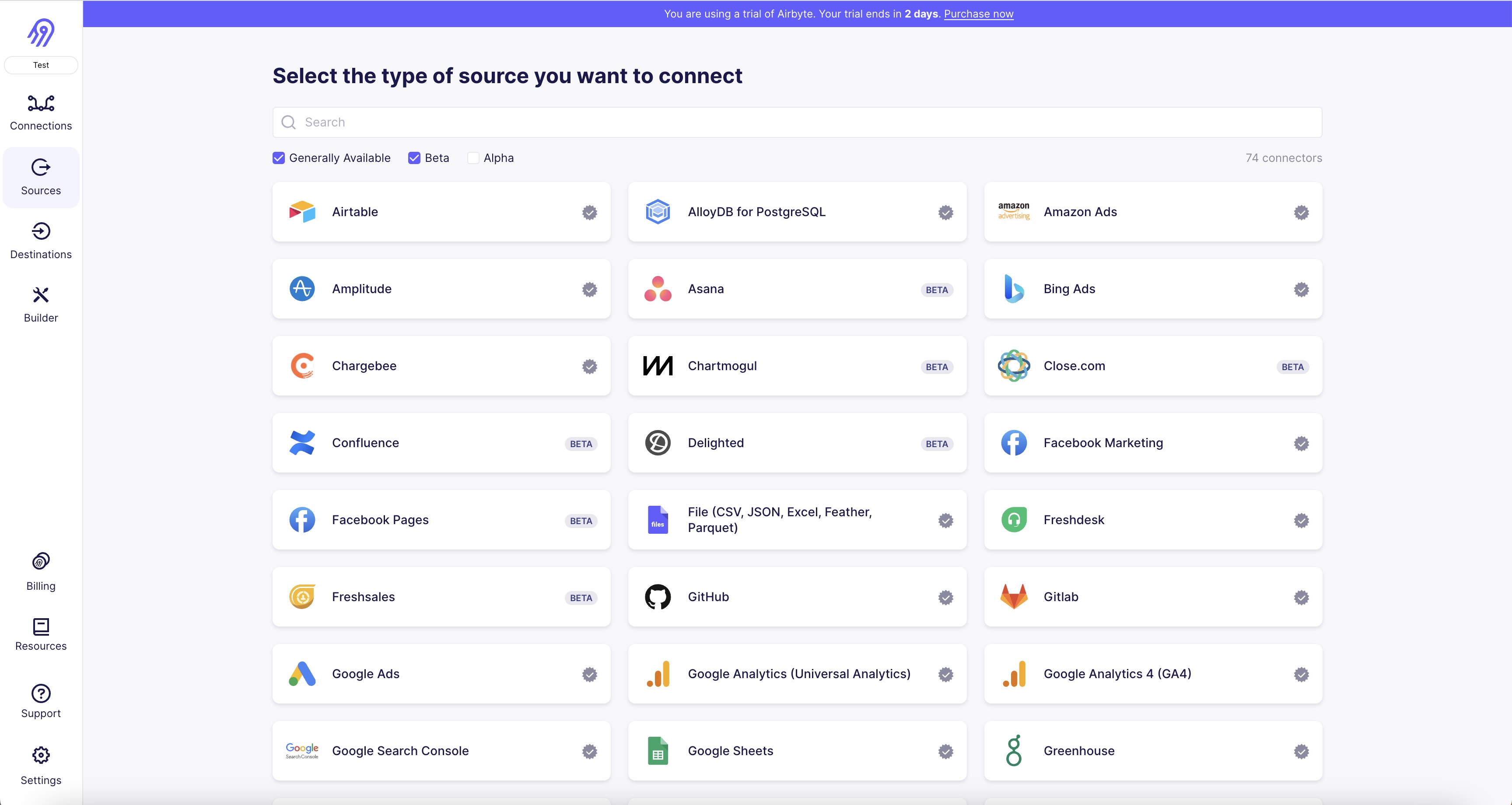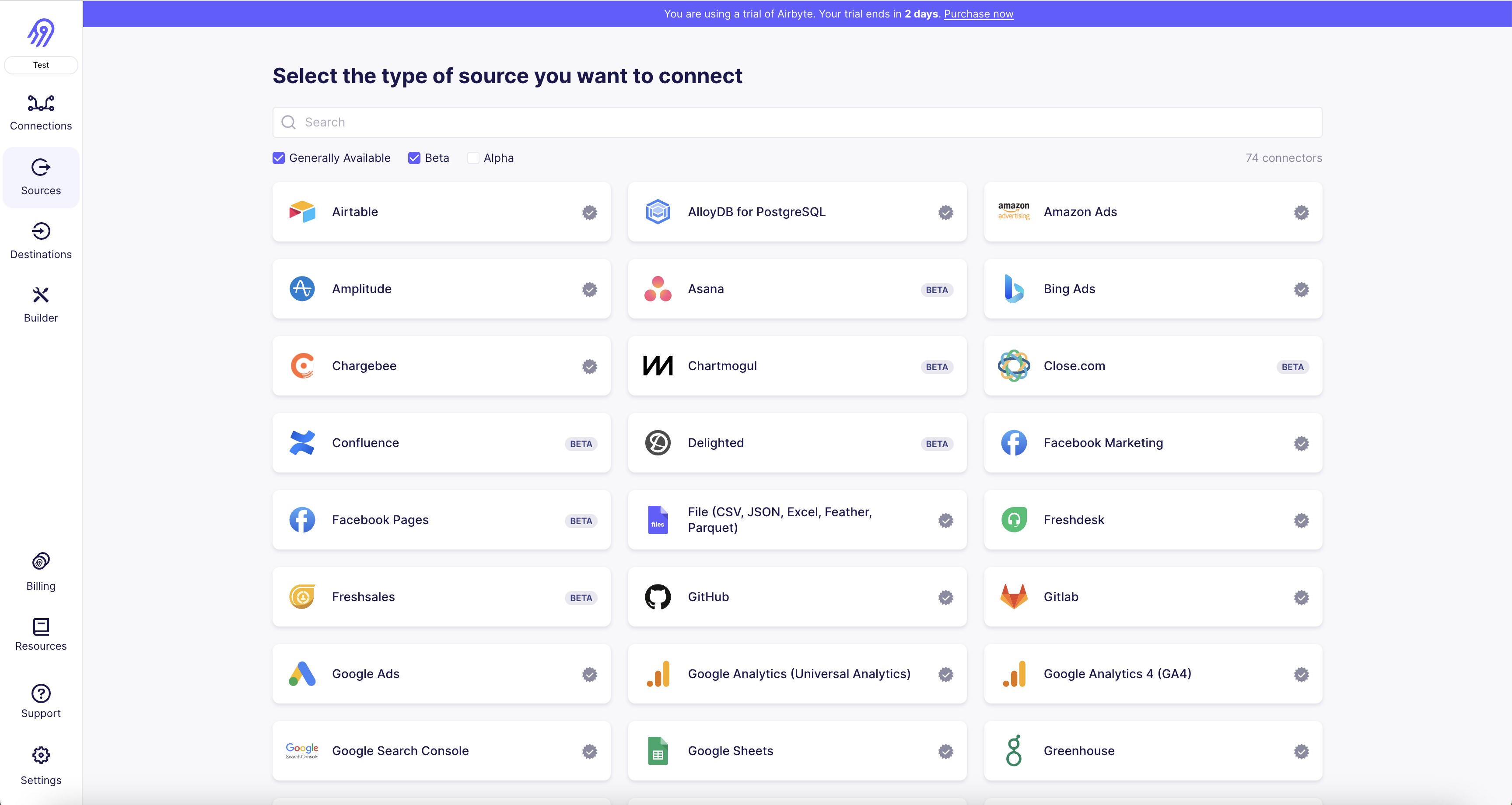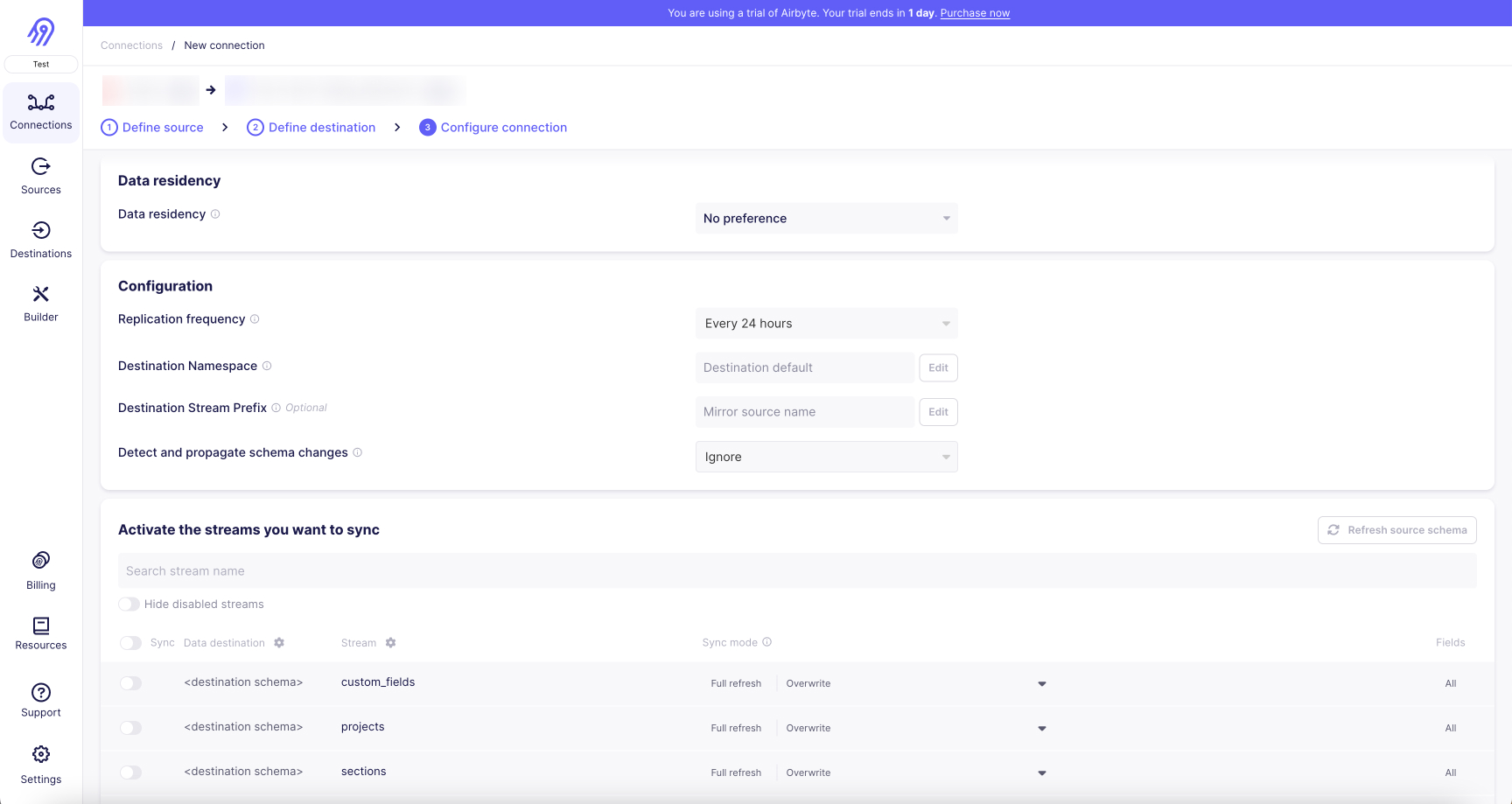

Building your pipeline or Using Airbyte
Airbyte is the only open solution empowering data teams to meet all their growing custom business demands in the new AI era.

- Inconsistent and inaccurate data
- Laborious and expensive
- Brittle and inflexible

- Reliable and accurate
- Extensible and scalable for all your needs
- Deployed and governed your way
Start syncing with Airbyte in 3 easy steps within 10 minutes
Take a virtual tour
Demo video of Airbyte Cloud
Demo video of AI Connector Builder
What sets Airbyte Apart
Modern GenAI Workflows
Move Large Volumes, Fast
An Extensible Open-Source Standard
Full Control & Security
Fully Featured & Integrated
Enterprise Support with SLAs
What our users say


"The intake layer of Datadog’s self-serve analytics platform is largely built on Airbyte.Airbyte’s ease of use and extensibility allowed any team in the company to push their data into the platform - without assistance from the data team!"


“Airbyte helped us accelerate our progress by years, compared to our competitors. We don’t need to worry about connectors and focus on creating value for our users instead of building infrastructure. That’s priceless. The time and energy saved allows us to disrupt and grow faster.”


“We chose Airbyte for its ease of use, its pricing scalability and its absence of vendor lock-in. Having a lean team makes them our top criteria. The value of being able to scale and execute at a high level by maximizing resources is immense”
FAQs
What is ETL?

ETL, an acronym for Extract, Transform, Load, is a vital data integration process. It involves extracting data from diverse sources, transforming it into a usable format, and loading it into a database, data warehouse or data lake. This process enables meaningful data analysis, enhancing business intelligence.

Asana is a computer software company specializing in work management and productivity. Providing a collaborative platform for teams from different professions, it is known for its ability to manage the largest and most complex business tasks. Asana helps replace overwhelming numbers of emails, spreadsheets, and reminders with a comprehensive solution that keeps everything you need in one place. Its extreme versatility enables businesses to monitor both day-to-day tasks and the overall progress and goals of entire projects.

Asana's API provides access to a wide range of data related to tasks, projects, teams, and users. The following are the categories of data that can be accessed through Asana's API:
1. Tasks: Information related to individual tasks, including their status, due date, assignee, and comments.
2. Projects: Data related to projects, including their name, description, and associated tasks.
3. Teams: Information about teams, including their name, description, and members.
4. Users: Data related to individual users, including their name, email address, and profile picture.
5. Tags: Information about tags used to categorize tasks and projects.
6. Attachments: Data related to files and other attachments associated with tasks and projects.
7. Custom Fields: Information about custom fields used to track additional data related to tasks and projects.
8. Workspaces: Data related to workspaces, including their name, description, and associated teams.
Overall, Asana's API provides access to a comprehensive set of data that can be used to build custom integrations and automate workflows.

What is ELT?

ELT, standing for Extract, Load, Transform, is a modern take on the traditional ETL data integration process. In ELT, data is first extracted from various sources, loaded directly into a data warehouse, and then transformed. This approach enhances data processing speed, analytical flexibility and autonomy.
Difference between ETL and ELT?

ETL and ELT are critical data integration strategies with key differences. ETL (Extract, Transform, Load) transforms data before loading, ideal for structured data. In contrast, ELT (Extract, Load, Transform) loads data before transformation, perfect for processing large, diverse data sets in modern data warehouses. ELT is becoming the new standard as it offers a lot more flexibility and autonomy to data analysts.
Asana is a computer software company specializing in work management and productivity. Providing a collaborative platform for teams from different professions, it is known for its ability to manage the largest and most complex business tasks. Asana helps replace overwhelming numbers of emails, spreadsheets, and reminders with a comprehensive solution that keeps everything you need in one place. Its extreme versatility enables businesses to monitor both day-to-day tasks and the overall progress and goals of entire projects.
Google Sheets is a cloud-based spreadsheet tool that allows users to create, edit, and share spreadsheets online. It is a part of the Google Drive suite of productivity tools and is accessible from any device with an internet connection. Google Sheets offers a range of features that make it a powerful tool for data analysis, project management, and collaboration. Users can create and format spreadsheets, add formulas and functions, and create charts and graphs to visualize data. Google Sheets also allows users to collaborate in real-time, making it easy to work on projects with others. Users can share spreadsheets with specific people or make them public, and can control who has access to edit or view the document. Additionally, Google Sheets integrates with other Google tools such as Google Forms, allowing users to collect data and automatically populate it into a spreadsheet. Overall, Google Sheets is a versatile and user-friendly tool that can be used for a variety of tasks, from simple calculations to complex data analysis.

1. First, navigate to the Asana source connector page on Airbyte.com.
2. Click on the "Add Source" button to begin the process of adding your Asana credentials.
3. In the "Connection Configuration" section, enter your Asana Personal Access Token. You can find instructions on how to generate a Personal Access Token in the Asana documentation.
4. Next, enter the Workspace ID for the Asana workspace you want to connect to. You can find your Workspace ID by going to the Asana API documentation and following the instructions provided.
5. In the "Sync Schema" section, you can choose which tables you want to sync data from. By default, all tables will be selected.
6. Once you have entered your credentials and selected your tables, click on the "Check Connection" button to ensure that your credentials are correct and that Airbyte can connect to your Asana workspace.
7. If the connection is successful, click on the "Create Source" button to finalize the process and begin syncing data from your Asana workspace to Airbyte.
8. You can now use Airbyte to transform and load your Asana data into your desired destination, such as a data warehouse or BI tool.

1. Go to the Airbyte website and log in to your account.
2. Click on the "Destinations" tab on the left-hand side of the screen.
3. Scroll down until you find the "Google Sheets" destination connector and click on it.
4. Click on the "Create Destination" button.
5. Enter a name for your destination and click on the "Create" button.
6. You will be redirected to the Google Sheets authorization page. Sign in to your Google account if you haven't already.
7. Click on the "Allow" button to grant Airbyte access to your Google Sheets account.
8. You will be redirected back to the Airbyte website. Select the Google Sheets destination you just created from the list of destinations.
9. Enter the name of the spreadsheet you want to use as your destination and select the worksheet you want to use.
10. Click on the "Test" button to make sure the connection is working properly.
11. If the test is successful, click on the "Save" button to save your destination settings.
12. You can now use the Google Sheets destination connector to transfer data from your source to your Google Sheets destination.

With Airbyte, creating data pipelines take minutes, and the data integration possibilities are endless. Airbyte supports the largest catalog of API tools, databases, and files, among other sources. Airbyte's connectors are open-source, so you can add any custom objects to the connector, or even build a new connector from scratch without any local dev environment or any data engineer within 10 minutes with the no-code connector builder.
We look forward to seeing you make use of it! We invite you to join the conversation on our community Slack Channel, or sign up for our newsletter. You should also check out other Airbyte tutorials, and Airbyte’s content hub!
What should you do next?
Hope you enjoyed the reading. Here are the 3 ways we can help you in your data journey:



TL;DR
This can be done by building a data pipeline manually, usually a Python script (you can leverage a tool as Apache Airflow for this). This process can take more than a full week of development. Or it can be done in minutes on Airbyte in three easy steps:
- set up Asana as a source connector (using Auth, or usually an API key)
- set up Google Sheets as a destination connector
- define which data you want to transfer and how frequently
You can choose to self-host the pipeline using Airbyte Open Source or have it managed for you with Airbyte Cloud.
This tutorial’s purpose is to show you how.
What is Asana
Asana is a computer software company specializing in work management and productivity. Providing a collaborative platform for teams from different professions, it is known for its ability to manage the largest and most complex business tasks. Asana helps replace overwhelming numbers of emails, spreadsheets, and reminders with a comprehensive solution that keeps everything you need in one place. Its extreme versatility enables businesses to monitor both day-to-day tasks and the overall progress and goals of entire projects.
What is Google Sheets
Google Sheets is a cloud-based spreadsheet tool that allows users to create, edit, and share spreadsheets online. It is a part of the Google Drive suite of productivity tools and is accessible from any device with an internet connection. Google Sheets offers a range of features that make it a powerful tool for data analysis, project management, and collaboration. Users can create and format spreadsheets, add formulas and functions, and create charts and graphs to visualize data. Google Sheets also allows users to collaborate in real-time, making it easy to work on projects with others. Users can share spreadsheets with specific people or make them public, and can control who has access to edit or view the document. Additionally, Google Sheets integrates with other Google tools such as Google Forms, allowing users to collect data and automatically populate it into a spreadsheet. Overall, Google Sheets is a versatile and user-friendly tool that can be used for a variety of tasks, from simple calculations to complex data analysis.
{{COMPONENT_CTA}}
Prerequisites
- A Asana account to transfer your customer data automatically from.
- A Google Sheets account.
- An active Airbyte Cloud account, or you can also choose to use Airbyte Open Source locally. You can follow the instructions to set up Airbyte on your system using docker-compose.
Airbyte is an open-source data integration platform that consolidates and streamlines the process of extracting and loading data from multiple data sources to data warehouses. It offers pre-built connectors, including Asana and Google Sheets, for seamless data migration.
When using Airbyte to move data from Asana to Google Sheets, it extracts data from Asana using the source connector, converts it into a format Google Sheets can ingest using the provided schema, and then loads it into Google Sheets via the destination connector. This allows businesses to leverage their Asana data for advanced analytics and insights within Google Sheets, simplifying the ETL process and saving significant time and resources.
Methods to Move Data From Asana to google sheets
- Method 1: Connecting Asana to google sheets using Airbyte.
- Method 2: Connecting Asana to google sheets manually.
Method 1: Connecting Asana to google sheets using Airbyte
Step 1: Set up Asana as a source connector

1. First, navigate to the Asana source connector page on Airbyte.com.
2. Click on the "Add Source" button to begin the process of adding your Asana credentials.
3. In the "Connection Configuration" section, enter your Asana Personal Access Token. You can find instructions on how to generate a Personal Access Token in the Asana documentation.
4. Next, enter the Workspace ID for the Asana workspace you want to connect to. You can find your Workspace ID by going to the Asana API documentation and following the instructions provided.
5. In the "Sync Schema" section, you can choose which tables you want to sync data from. By default, all tables will be selected.
6. Once you have entered your credentials and selected your tables, click on the "Check Connection" button to ensure that your credentials are correct and that Airbyte can connect to your Asana workspace.
7. If the connection is successful, click on the "Create Source" button to finalize the process and begin syncing data from your Asana workspace to Airbyte.
8. You can now use Airbyte to transform and load your Asana data into your desired destination, such as a data warehouse or BI tool.
Step 2: Set up Google Sheets as a destination connector

1. Go to the Airbyte website and log in to your account.
2. Click on the "Destinations" tab on the left-hand side of the screen.
3. Scroll down until you find the "Google Sheets" destination connector and click on it.
4. Click on the "Create Destination" button.
5. Enter a name for your destination and click on the "Create" button.
6. You will be redirected to the Google Sheets authorization page. Sign in to your Google account if you haven't already.
7. Click on the "Allow" button to grant Airbyte access to your Google Sheets account.
8. You will be redirected back to the Airbyte website. Select the Google Sheets destination you just created from the list of destinations.
9. Enter the name of the spreadsheet you want to use as your destination and select the worksheet you want to use.
10. Click on the "Test" button to make sure the connection is working properly.
11. If the test is successful, click on the "Save" button to save your destination settings.
12. You can now use the Google Sheets destination connector to transfer data from your source to your Google Sheets destination.
Step 3: Set up a connection to sync your Asana data to Google Sheets

Once you've successfully connected Asana as a data source and Google Sheets as a destination in Airbyte, you can set up a data pipeline between them with the following steps:
- Create a new connection: On the Airbyte dashboard, navigate to the 'Connections' tab and click the '+ New Connection' button.
- Choose your source: Select Asana from the dropdown list of your configured sources.
- Select your destination: Choose Google Sheets from the dropdown list of your configured destinations.
- Configure your sync: Define the frequency of your data syncs based on your business needs. Airbyte allows both manual and automatic scheduling for your data refreshes.
- Select the data to sync: Choose the specific Asana objects you want to import data from towards Google Sheets. You can sync all data or select specific tables and fields.
- Select the sync mode for your streams: Choose between full refreshes or incremental syncs (with deduplication if you want), and this for all streams or at the stream level. Incremental is only available for streams that have a primary cursor.
- Test your connection: Click the 'Test Connection' button to make sure that your setup works. If the connection test is successful, save your configuration.
- Start the sync: If the test passes, click 'Set Up Connection'. Airbyte will start moving data from Asana to Google Sheets according to your settings.
Remember, Airbyte keeps your data in sync at the frequency you determine, ensuring your Google Sheets data warehouse is always up-to-date with your Asana data.
Method 2: Connecting Asana to google sheets manually
Moving data from Asana to Google Sheets without using third-party connectors or integrations can be achieved through Asana's API and Google Sheets API. This process will require some programming knowledge, particularly with HTTP requests and handling JSON data. Below is a step-by-step guide for a developer to accomplish this task:
Step 1: Set up Google Sheets API Access
1. Go to the Google Developers Console: https://console.developers.google.com/
2. Create a new project or select an existing one.
3. Enable the Google Sheets API for your project:
- In the dashboard, click on "Enable APIs and Services."
- Search for "Google Sheets API" and enable it.
4. Configure the OAuth consent screen.
5. Create credentials (OAuth client ID) for your application:
- Choose "Web application" or "Other" as the application type.
- Save the client ID and client secret.
Step 2: Set up Asana Access
1. Go to Asana's Developers Console: https://app.asana.com/-/developer_console
2. Create a new app or use an existing one.
3. Generate a personal access token (PAT) for authenticating API requests.
Step 3: Write the Code to Fetch Data from Asana
1. Choose a programming language (e.g., Python, JavaScript, etc.).
2. Write a function to make an HTTP GET request to the Asana API to fetch the desired data:
- Use the endpoint `https://app.asana.com/api/1.0/projects/PROJECT_ID/tasks` to get tasks for a specific project.
- Include the personal access token in the Authorization header.
- Parse the JSON response to extract the necessary data.
Step 4: Write the Code to Insert Data into Google Sheets
1. Use the Google Sheets API client library for your chosen language.
2. Authenticate using the OAuth credentials created in Step 1.
3. Define the spreadsheet ID and the range where you want to insert the data.
4. Write a function to insert data into the specified range using the Google Sheets API.
Step 5: Combine the Code and Execute
1. Combine the code from Step 3 and Step 4 into a single script or application.
2. Call the function to fetch data from Asana.
3. Process and structure the data as needed for Google Sheets.
4. Call the function to insert data into Google Sheets.
5. Run the script and check Google Sheets to confirm the data transfer.
Example Code Snippet (Python)
```python
import requests
from google.oauth2.credentials import Credentials
from googleapiclient.discovery import build
# Asana API request
asana_token = 'your_asana_personal_access_token'
asana_headers = {'Authorization': 'Bearer ' + asana_token}
asana_project_url = 'https://app.asana.com/api/1.0/projects/PROJECT_ID/tasks'
asana_response = requests.get(asana_project_url, headers=asana_headers)
asana_tasks = asana_response.json()['data']
# Process Asana tasks as needed
# ...
# Google Sheets API request
google_creds = Credentials.from_authorized_user_file('credentials.json')
service = build('sheets', 'v4', credentials=google_creds)
spreadsheet_id = 'your_spreadsheet_id'
range_name = 'Sheet1!A1'
values = [
# Data from Asana tasks processed into a list of lists
# ...
]
body = {'values': values}
result = service.spreadsheets().values().update(
spreadsheetId=spreadsheet_id, range=range_name,
valueInputOption='RAW', body=body).execute()
```
Notes:
- Replace `your_asana_personal_access_token`, `PROJECT_ID`, `credentials.json`, and `your_spreadsheet_id` with your actual Asana token, project ID, Google credentials file, and spreadsheet ID.
- This code snippet assumes you have already set up OAuth 2.0 authorization and have a `credentials.json` file for Google Sheets API.
- The code is a high-level example and will need to be adapted to your specific use case, including error handling and data processing.
Step 6: Schedule the Script (Optional)
If you need to move data regularly, you can schedule the script to run at certain intervals using a task scheduler:
- On Linux, use cron jobs.
- On Windows, use Task Scheduler.
- On macOS, use launchd or cron jobs.
Step 7: Monitor and Maintain
Periodically check the script's execution logs to ensure it's running as expected. Update the script if there are any changes to the Asana API or Google Sheets API that affect its functionality.
By following these steps and using the provided example as a starting point, a developer should be able to move data from Asana to Google Sheets without third-party connectors or integrations. Remember to handle errors and edge cases in your script to make it robust.
Use Cases to transfer your Asana data to Google Sheets
Integrating data from Asana to Google Sheets provides several benefits. Here are a few use cases:
- Advanced Analytics: Google Sheets’s powerful data processing capabilities enable you to perform complex queries and data analysis on your Asana data, extracting insights that wouldn't be possible within Asana alone.
- Data Consolidation: If you're using multiple other sources along with Asana, syncing to Google Sheets allows you to centralize your data for a holistic view of your operations, and to set up a change data capture process so you never have any discrepancies in your data again.
- Historical Data Analysis: Asana has limits on historical data. Syncing data to Google Sheets allows for long-term data retention and analysis of historical trends over time.
- Data Security and Compliance: Google Sheets provides robust data security features. Syncing Asana data to Google Sheets ensures your data is secured and allows for advanced data governance and compliance management.
- Scalability: Google Sheets can handle large volumes of data without affecting performance, providing an ideal solution for growing businesses with expanding Asana data.
- Data Science and Machine Learning: By having Asana data in Google Sheets, you can apply machine learning models to your data for predictive analytics, customer segmentation, and more.
- Reporting and Visualization: While Asana provides reporting tools, data visualization tools like Tableau, PowerBI, Looker (Google Data Studio) can connect to Google Sheets, providing more advanced business intelligence options. If you have a Asana table that needs to be converted to a Google Sheets table, Airbyte can do that automatically.
Wrapping Up
To summarize, this tutorial has shown you how to:
- Configure a Asana account as an Airbyte data source connector.
- Configure Google Sheets as a data destination connector.
- Create an Airbyte data pipeline that will automatically be moving data directly from Asana to Google Sheets after you set a schedule
With Airbyte, creating data pipelines take minutes, and the data integration possibilities are endless. Airbyte supports the largest catalog of API tools, databases, and files, among other sources. Airbyte's connectors are open-source, so you can add any custom objects to the connector, or even build a new connector from scratch without any local dev environment or any data engineer within 10 minutes with the no-code connector builder.
We look forward to seeing you make use of it! We invite you to join the conversation on our community Slack Channel, or sign up for our newsletter. You should also check out other Airbyte tutorials, and Airbyte’s content hub!
What should you do next?
Hope you enjoyed the reading. Here are the 3 ways we can help you in your data journey:



Ready to get started?
Frequently Asked Questions
Asana's API provides access to a wide range of data related to tasks, projects, teams, and users. The following are the categories of data that can be accessed through Asana's API:
1. Tasks: Information related to individual tasks, including their status, due date, assignee, and comments.
2. Projects: Data related to projects, including their name, description, and associated tasks.
3. Teams: Information about teams, including their name, description, and members.
4. Users: Data related to individual users, including their name, email address, and profile picture.
5. Tags: Information about tags used to categorize tasks and projects.
6. Attachments: Data related to files and other attachments associated with tasks and projects.
7. Custom Fields: Information about custom fields used to track additional data related to tasks and projects.
8. Workspaces: Data related to workspaces, including their name, description, and associated teams.
Overall, Asana's API provides access to a comprehensive set of data that can be used to build custom integrations and automate workflows.
What should you do next?
Hope you enjoyed the reading. Here are the 3 ways we can help you in your data journey:











